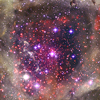CXC Home | Search | Help | Image Use Policy | Latest Images | Privacy | Accessibility | Glossary | Q&A
Tour of Rosette Nebula
Quicktime MPEG
This spectacular image shows the Rosette star formation region, which is located about 5,000 light years from Earth. X-rays from the Chandra X-ray Observatory reveal hundreds of young stars clustered in the center of the image and additional fainter clusters on either side. Optical data from the Digitized Sky Survey and the Kitt Peak National Observatory show large areas of gas and dust, including giant pillars that remain behind after intense radiation from massive stars has eroded the more diffuse gas. The combination of the X-ray and optical data lead astronomers to believe that stars are still forming in the central cluster of the Rosette, known as NGC 2237. Astronomers are also using these data to piece together the history of this gorgeous region. The Rosette Nebula has long been a favorite target of amateur astronomers in the constellation the Unicorn. The wispy colorful structures in the optical data can sometimes be seen by small telescopes from the ground here on Earth.
[Runtime: 1:13]
Quicktime MPEG
This spectacular image shows the Rosette star formation region, which is located about 5,000 light years from Earth. X-rays from the Chandra X-ray Observatory reveal hundreds of young stars clustered in the center of the image and additional fainter clusters on either side. Optical data from the Digitized Sky Survey and the Kitt Peak National Observatory show large areas of gas and dust, including giant pillars that remain behind after intense radiation from massive stars has eroded the more diffuse gas. The combination of the X-ray and optical data lead astronomers to believe that stars are still forming in the central cluster of the Rosette, known as NGC 2237. Astronomers are also using these data to piece together the history of this gorgeous region. The Rosette Nebula has long been a favorite target of amateur astronomers in the constellation the Unicorn. The wispy colorful structures in the optical data can sometimes be seen by small telescopes from the ground here on Earth.
[Runtime: 1:13]
(Credits: X-ray (NASA/CXC/SAO/J. Wang et al), Optical (DSS & NOAO/AURA/NSF/KPNO 0.9-m/T. Rector et al))
Return to Rosette Nebula (September 8, 2010)



